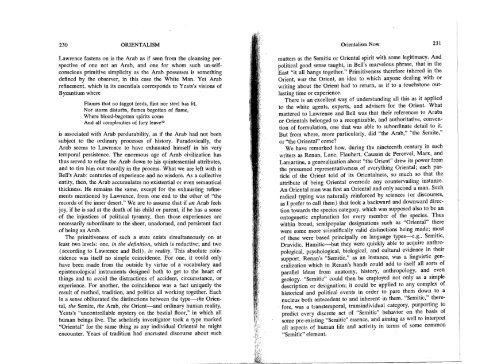Orientalism - autonomous learning
Orientalism - autonomous learning
Orientalism - autonomous learning
Create successful ePaper yourself
Turn your PDF publications into a flip-book with our unique Google optimized e-Paper software.
230 ORIENTALISM<br />
<strong>Orientalism</strong> Now<br />
231<br />
Lawrence fastens on is the Arab as if seen from the cleansing perspective<br />
of one not an Arab, and one for whom such un-selfconscious<br />
primitive simplicity as the Arab possesses is something<br />
defined by the observer, in this case the White Man. Yet Arab<br />
refinement, which in its essentials corresponds to Yeats's visions of<br />
Byzantium where<br />
Flames that no faggot feeds, flint nor steel has lit, <br />
Nor storm disturbs, flames begotten of flame, <br />
Where blood-begotten spirits come <br />
And all complexities of fury leave 32 <br />
is associated with Arab perdurability, as if the Arab had not been<br />
subject to the ordinary processes of history. Paradoxically, the<br />
Arab seems to Lawrence to have exhausted himself in his very<br />
temporal persistence. The enormous age of Arab civilization has<br />
thus served to refine the Arab down to his quintessential attributes,<br />
and to tire him out morally in the process. What we are left with is<br />
Bell's Arab: centuries of experience and no wisdom. As a collective<br />
entity, then, the Arab accumulates no existential or even seman tical<br />
thickness. He remains the same, except for the exhausting refinements<br />
mentioned by Lawrence, from one end to the other of "the<br />
records of the inner desert." We are to assume that if an Arab feels<br />
joy, if he is sad at the death of his child or parent, if he has a sense<br />
of the injustices of political tyranny, then those experiences are<br />
necessarily subordinate to the sheer, unadorned, and persistent fact<br />
of being an Arab.<br />
The primitiveness of such a state exists simultaneously on at<br />
least two levels: one, in the definition, which is reductive; and two<br />
(according to Lawrence and Bell), in reality. This absolute coincidence<br />
was itself no simple coincidence. For one, it could only<br />
have been made from the outside by virtue of a vocabulary and<br />
epistemological instruments designed both to get to the heart of<br />
things and to avoid the distractions of accident, circumstance, or<br />
experience. For another, the coincidence was a fact uniquely the<br />
result of method, tradition, and politics all working together. Each<br />
in a sense obliterated the distinctions between the type-the Oriental,<br />
the Semite, the Arab, the Orient-and ordinary human reality,<br />
Yeats's "uncontrollable mystery on the bestial floor," in which all<br />
human beings live. The scholarly investigator took a type marked<br />
"Oriental" for the same thing as any individual Oriental he might<br />
encounter. Years of tradition had encrusted discourse about such<br />
matters as the Semitic or Oriental spirit with some legitimacy. And<br />
political good sense taught, in Bell's marvelous phrase, that in the<br />
East "it all hangs together." Primitiveness therefore inhered in the<br />
Orient, was the Orient, ,an idea to which anyone dealing with or<br />
writing about the Orient had to return, as if to a touchstone outlasting<br />
time or experience.<br />
There is an excellent way of understanding all this as it applied<br />
to the white agents, experts, and advisers for the Orient. What<br />
mattered to Lawrence and Bell was that their references to Arabs<br />
or Orientals belonged to a recognizable, and authoritative, convention<br />
of formulation, one that was able to subordinate detail to it.<br />
But from where, more particularly, did "the Arab," "the Semite,"<br />
or "the Oriental" come?<br />
We have remarked how, during the nineteenth century in such<br />
writers as Renan, Lane, Flaubert, Caussin de Perceval, Marx, and<br />
Lamartine, a generalization about "the Orient" drew its power from<br />
the presumed representativeness of everything Oriental; each particle<br />
of the Orient told of its Orientalness, so much so that the<br />
attribute of being Oriental overrode any countervailing instance.<br />
An Oriental man was first an Oriental and only second a man. Such<br />
radical typing was naturally reinforced by sciences (or discourses,<br />
as I prefer to call them) that took a backward and downward direction<br />
towards the species category, which was supposed also to be an<br />
ontogenetic explanation for every member of the species. Thus<br />
within broad, semipopular designations such as "Oriental" there<br />
were some more scientifically valid distinctions being made; most<br />
of these were based principally on language types--e.g., Semitic,<br />
Dravidic, Hamitic-but they were quickly able to acquire anthropological,<br />
psychological, biological, and cultural evidence in their<br />
support. Renan's "Semitic," as an instance; was a linguistic generalization<br />
which in Renan's hands could add to itself all sorts of<br />
parallel ideas from anatomy, history, anthropology, and even<br />
geology. "Semitic" could then be employed not only as a simple<br />
description or designation; it could be applied to any complex of<br />
historical and political events in order to pare them down to a<br />
nucleus both antecedent to and inherent in them. "Semitic," there<br />
. fore, was a transtemporal, transindividual category, purporting to<br />
predict every discrete act of "Semitic" behavior on the basis of<br />
some pre-existing "Semitic" essence, and aiming as well to interpret<br />
all aspects of human life and activity in terms of some common<br />
"Semitic" element.
















